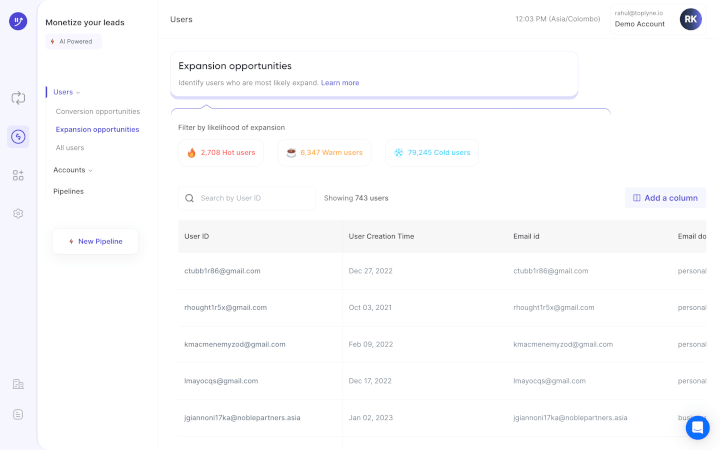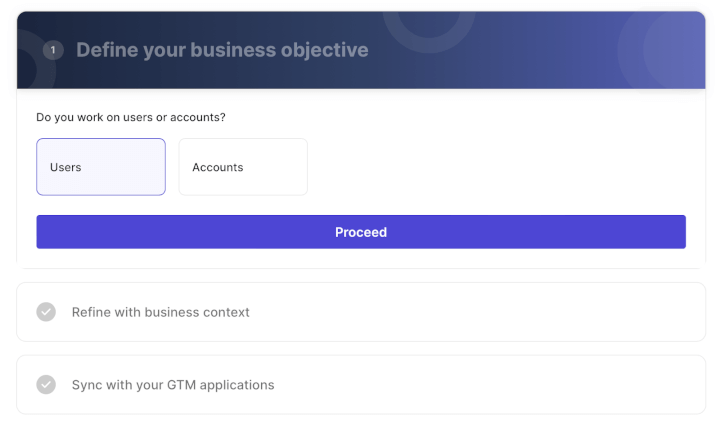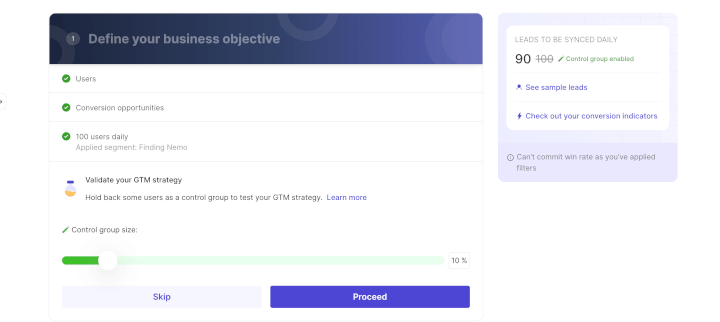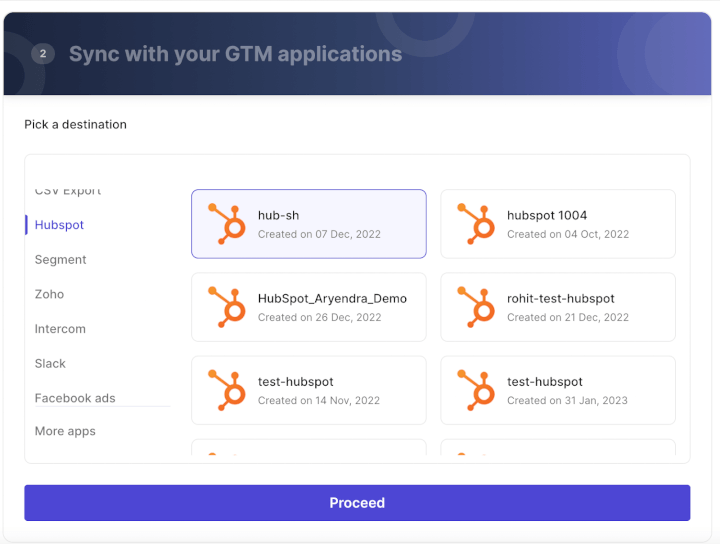The Ultimate Guide To Firmographic Data

Making informed decisions based on data is critical for business success. You don’t want to be left behind because you didn’t have the right information to steer your business forward, right?
Here’s where firmographic data comes in for B2B businesses - it defines the characteristics of potential customer organizations.
Firmographic data empowers you to enhance marketing and sales outcomes, effectively segment your audience, and create personalized content that converts prospects into loyal customers.
In this article, we’ll guide you through the A-Z of firmographic data, and we’ll also provide a few actionable strategies to elevate your sales and marketing efforts.
Defining Firmographic Data
Firmographic data refers to specific information about businesses, such as their size, industry, location, and revenue, used for targeted B2B marketing and sales strategies.
For B2B businesses, knowing your target market is vital, and firmographic data takes center stage in this quest.
Some key components of firmographic data include:
- Company size
- Industry sector
- Geographic location(s)
- Annual revenue
- Number of employees
- Ownership structure
- Performance metrics
Before we dive deeper into firmographic data, let’s have a look at what sets it apart from the more popularly used demographic data.
Distinctions Between Firmographic and Demographic Data
In the world of data-driven sales strategies, two key players take the stage: firmographic data and demographic data. Both hold valuable insights, but they focus on different realms.
Demographic data zeroes in on individual information, encompassing details like gender, age, profession, income, and family status.
On the other hand, firmographic data shifts the spotlight to organizations or businesses themselves. It delves into crucial characteristics such as industry, location, size, status or structure, and performance metrics.
The distinction is clear: demographics revolve around people, while firmographics revolve around organizations. Want to understand more about how firmographic data is different from other B2B intent data? Here's your ultimate guide to B2B intent data vs. firmographic data.
Let’s take a detailed look into the key elements of firmographic data.
Key Elements of Firmographic Data
Company Characteristics and Attributes
Firmographic data encompassing revenue, company name, years in business, financial performance, and company size, equips businesses and salespeople with the insights needed to make informed decisions and optimize their marketing efforts.
Company size, measured through factors like revenue and staff count, plays a vital role in crafting successful sales messaging, as different campaigns resonate better with businesses of varying sizes.
Evaluating a company's years in business through firmographic data also aids in making strategic decisions.
Industry and Market Segmentation
With firmographic data, market segmentation also becomes more efficient, allowing you to differentiate your approach for different customer industries and segments, optimizing your strategies for maximum impact.
Geographic Location and Distribution
By collecting location data, you can ensure your outreach startegies align with the geographic range of your target audience. Moreover, location data facilitates efficient resource allocation by filtering out non-relevant companies within a specific region.
Organizational Structure and Hierarchy
Successful sales prospecting lies in identifying the right individuals to connect with - and understanding the organizational structure and hierarchy of target businesses is paramount for effective B2B marketing, providing valuable insights to build long-term relationships with customers.
But how is this data collected?
Let’s take a closer look.
Sources and Collection of Firmographic Data
There are 3 major sources for the collection of firmographic data. This includes:
Internal Sources: CRM, Sales Systems, and Customer Data
A great internal source for firmographic data is your in-house customer relationship management (CRM) software. These centralized databases consolidate data on existing customers and prospects, streamlining access and analysis.
By integrating firmographic data into your CRM, you can track customer interactions and behaviors over time, refining your outreach strategies and nurturing long-term relationships.
Surveys are also a popular way to collect customer data - allowing you to tailor questions and gain real-time insights into customer and company characteristics, such as company size, industry, and location.
External Sources: Market Research Reports and Databases
To effectively collect firmographic data, you can leverage external sources like company websites and public databases.
Market research reports, white papers, and databases offer essential details like business names, industry categories, locations, revenues, and company leadership. While this low-cost approach provides valuable insights, be mindful of potential limitations, such as outdated or insufficient data for precise targeting.
Data Providers and Data Enrichment Services
Data providers and data enrichment services play a vital role in acquiring essential firmographic data that may not be readily available from leads. These third-party tools offer comprehensive firmographic insights, providing core data like annual revenue, recent funding, employee count, and industry classification.
They may also offer contact information of relevant individuals, including names, positions, emails, and phone numbers. Although there may be a slight risk of outdated data, these tools prove highly beneficial in qualifying leads effectively and filling in information gaps.
Top data enrichment tools like ZoomInfo and Lead Forensics are widely trusted and used in the market. Here are top 4 firmographic tools you need in your sales tech stack.
Applications of Firmographic Data
Let’s have a look at some use cases of firmographic data:
Targeted Marketing and Customer Segmentation
Segmenting potential customers by firmographic attributes enables targeted outreach and sales engagement campaigns, resulting in higher conversion rates and fostering customer retention.
Lead Generation and Lead Scoring
Firmographic segmentation benefits both inbound (tailored website content) and outbound (data-driven targeted outreach) lead gen efforts when combined with targeted marketing efforts.
Plus, it’s really helpful with lead scoring - firmographic data in your lead generation funnel allows your sales team to accurately assess the potential value and readiness of each incoming lead through a ranking system.
Check out Toplyne - the behavioral lead-scoring platform used by Canva and Vercel.
Here’s how companies like Canva and Vercel generate sales pipeline from their self-serve funnel using Toplyne:
- Step 1/7: Create monetization playbooks to surface conversion and expansion opportunities (leads most likely to convert to paying customers, and teams most likely to grow into larger teams)

- Step 2/7: Choose the right leads to target – users (individual users) or accounts (a group of users with an organization).

- Step 3/7: Select the frequency at which you would want leads synced in your GTM apps.

- Step 4/7: Define how many leads you want by either the number of leads or your expected win rate, depending on your sales capacity and GTM strategy.

- Step 5/7: Build custom segments - Build custom segments based on And/Or logic at the deepest level of sub-properties within your product analytics.

- Step 6/7: Validate your GTM strategy - Hold back some users as a control group to test your GTM strategy.

- Step 7/7: Sync your product qualified pipeline into your GTM destinations - CRMs, sales & marketing execution tools, and customer engagement platforms.

Account-Based Marketing (ABM) Strategies
Unlike traditional marketing, ABM focuses on personalized approaches, requiring the identification of companies that align with your ideal customer profile.
Firmographic data serves as the foundation for finding companies that align with your ideal customer profile. It helps tailored email campaigns and A/B testing initiatives that resonate with the target audience.
This data-driven strategy ensures marketing efforts are concentrated on high-quality leads and perfect-fit companies, maximizing engagement and relevance.
Benefits of Firmographic Data
Enhanced Personalization in Sales
Tailoring messaging based on relevant firmographic data ensures precision in sales targeting.
With this, you can comprehend an organization's status, future plans, and specific needs, enabling personalized communication for the right person at the right time.
Better Understanding of Customer Needs and Pain Points
90% of sales reps in high-performance teams say they prioritize long-term customer relations over short wins.
Customer segmentation using firmographic data points enables targeted messaging that resonates with each segment’s customer needs, fostering better engagement.
Improved Sales Targeting and Conversion Rates
Those who leverage third-party data sources are 2.09 times more likely to achieve an impression-to-form-fill conversion rate of 10% or higher.
Firmographic data empowers your sales team to precisely segment and target and connect with qualified prospects - all leading to shorter sales cycles and better conversion rates.
You can do this easily with Toplyne - our behavioral AI engine combines your first-party data from product analytics, CRM, and billing with third-party enrichment data to find the right accounts for you to target.
Implementing Firmographic Data in Business Strategies
Defining Ideal Customer Profiles (ICPs)
Understanding the kind of companies that face the problem your product solves is the first step toward determining your ideal customer profile.
Firmographic data forms the backbone of the process here - it helps you identify companies which face the problem and help you define specs of your ICP in terms of location, revenue, and size.
Leveraging Firmographic Data for Market Segmentation
Segmenting potential customers based on firmographic data attributes empowers you to design focused and personalized marketing campaigns.
And when you address the specific needs of each segment, you’re likely to achieve higher conversion rates and better ROI.
Integrating Firmographic Insights into Sales Processes
Using firmographic data in your workflow helps tailor lead generation efforts for seamless customer conversion.
Your sales teams can use this data to:
- Enhance targeting and segmentation
- Improve lead scoring and qualification
- Bettering converion rate by tailoring sales collateral, outreach messaging, and demos
Toplyne is a behavioral lead scoring platform that combines your product usage data, billing data, CRM data, and layers in third-party enrichment like firmographic data, technographics, and intent data to find sales pipeline from your self-serve funnel, all with zero change management.
Need a deeper dive? Here's how you can unlock your sales team's potential using firmographic data.
Key Takeaways
Analyzing B2B data empowers you to make data-driven decisions. Let’s look at a quick recap:
- Firmographic data offers valuable insights into target customers and business hierarchy for cultivating long-term relationships.
- It enables customer segmentation based on industry, company size, location, and organizational hierarchy, leading to more tailored outreach and personalized sales strategies.
- It allows for improved sales targeting, better lead prioritization, and increased conversion rates, driving business growth.
By embracing firmographic data in your strategies, you can maximize your sales outreach efforts, foster strong connections with prospects, and remain competitive in dynamic B2B markets.


.svg)









.png)